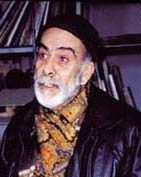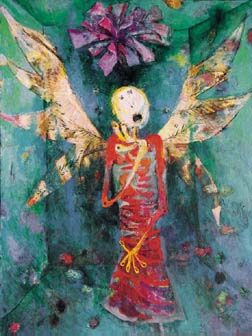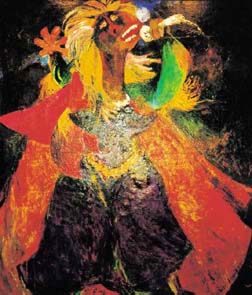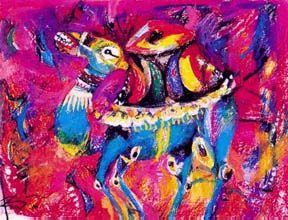|

Summer
1999 (7.2)
Page
19
Rasim Babayev
(1926-2007)
The World
of Divs and Angels
Visit AZgallery.org for more works of Rasim Babayev
  Many of Rasim Babayev's
paintings seem like they belong in a fairy-tale collection designed
to trigger nightmares. He's known for drawing many-fingered,
many-legged and many-headed horned monsters baring several sets
of teeth, which threaten tiny, helpless humans. The white teeth
stand out in stark contrast against dark purples, blues and splashes
of crimson. But these monsters, known as "Divs" ("devils"
in Azerbaijani fairy tales), are not just imaginary. Many of Rasim Babayev's
paintings seem like they belong in a fairy-tale collection designed
to trigger nightmares. He's known for drawing many-fingered,
many-legged and many-headed horned monsters baring several sets
of teeth, which threaten tiny, helpless humans. The white teeth
stand out in stark contrast against dark purples, blues and splashes
of crimson. But these monsters, known as "Divs" ("devils"
in Azerbaijani fairy tales), are not just imaginary.
According to Rasim, they symbolize totalitarianism, specifically
the terror of the Soviet system. Despite the ban on any artistic
expression that did not reflect "Social Realism", Rasim
managed to get away with depicting them on his canvases under
the guise of "Primitivism". In a recent interview with
our staff, he described the circumstances that led him to paint
Divs, and now to even include angels on his canvases, as Azerbaijan
begins its journey towards independence.
_____
I began studying in Moscow's Art Institute in 1949. When I was
a third-year student, I made a painting of my brother and a few
of his friends down by the sea. There was much that was different
about that work. The colors were not conventional; also, the
body lines of my figures were not realistic.
When I presented the painting to the Institute's Committee, they
looked at it but wouldn't give me a grade for it. Later, the
secretary came and asked me to pay a visit to Rector Madorov's
office. When I did, I found several other professors gathered
in his study as well. They reproached me: "What have you
done, Babayev? This is not what we call art. Why have you gone
down the wrong path? You studied so well your first year. You
were an excellent student-what has happened to you?"
One of the professors asked me: "Where could you possibly
have seen a sea that was this color?"
I replied, "I wonder if you've ever seen our sea?"
He said that yes, he had been to Baku and yes, he had seen the
Caspian Sea.
I told him, "But you haven't looked at our sea with my eyes.
If a hundred men describe a certain object, each one will describe
it in his own way."
  I was asked to leave
the room and wait out in the corridor while they continued discussing
my work. Then Professor Nevejny came out of the study and tried
to console me: "Take it easy-things like this happen. I
know that the 1930s have had a negative influence on you [referring
to the Stalinist repression] and now you are being influenced
by the West. You'll soon get over it and forget about all these
things." I was asked to leave
the room and wait out in the corridor while they continued discussing
my work. Then Professor Nevejny came out of the study and tried
to console me: "Take it easy-things like this happen. I
know that the 1930s have had a negative influence on you [referring
to the Stalinist repression] and now you are being influenced
by the West. You'll soon get over it and forget about all these
things."
They were about to throw me out of the university. For some reason,
they didn't. After that incident, the professors picked on me.
Once the Rector told me, "You can't paint. You just spread
the colors around and don't actually show what you are trying
to represent."
More Trouble
When I was due to graduate, the Committee refused to give me
my diploma because they didn't like my final project, a painting
called "Fishermen." I had painted the fisheries I had
seen in Salyan [a region in Azerbaijan located on the northern
coast of the Caspian Sea]. They looked at the work and said that
they couldn't accept it because the people looked like Americans,
not Soviets. I told them that I had never been to America or
laid eyes on an American except in a few American movies. I was
supposed to get my diploma the following day, but they refused
to give it to me.
In 1964, an Artists' All-Union Congress was held here in Baku.
When I ran into the Institute's Rector who had come from Moscow,
he paused and told me, "If my memory serves me right, you
have yet to receive your diploma." I admitted that he was
right - no, I didn't have my diploma. By that time I had become
an official member not only of the Artists' Union in Azerbaijan
but of the Artists' Union of the USSR as well, so he suggested
that I go and pick up my diploma. But I told him: "You can
keep my diploma. I give it to you. I don't need it anymore."
And I didn't.
When I first started studying art, I didn't understand the deficiencies
of the Soviet system. It was as if I was wandering in a daze.
In 1950, as a first-year student in Moscow, I visited the Pushkin
Fine Arts Museum nearly every day. There the works of world-renowned
artists such as Rembrandt, Gustave Courbet, Michelangelo and
Rafael inspired me tremendously. Of course, many of the works
were copies, although there were some originals as well. Still,
it was a revelation to me to see them.
But later that year a very strange thing happened: the museum
was closed in preparation for Stalin's 70th Jubilee [birthday
celebration]. The museum's art was replaced by an exhibition
displaying the personal gifts that Stalin had received. This
absurdity angered me and I trace my awakening and the beginnings
of my protests against the Soviet system to that event.
After I left the university, I worked in Moscow for a year, but
soon realizing that Moscow was not the right place for me, I
returned to Baku.
 20th Century Art in Azerbaijan 20th Century Art in Azerbaijan
During the 20th century, Azerbaijani art has been influenced
by various schools of art. At the beginning of this century,
two German artists came to Baku - Otto Schmerling and Rotter.
They did graphics plus a lot of other work for Molla Nasraddin,
a magazine of political satire [1906-1931].
Azim Azimzade, the man for whom the major art school in Baku
is named, was also creating at the time. He was a great artist.
I only had the chance to watch him draw once - it was on TV.
His method was amazing. He drew one line, and then another. After
two to three lines, an image appeared of a woman wearing a chador
[veil]. Even though Azimzade never received any special training,
he was considered one of the founders of formal painting in Azerbaijan.
Then there was Bahruz Kangarli. He was an educated artist, having
studied at the Tbilisi Academy. There were also a lot of Russian
and Ukrainian artists in Baku (Gerasimov, Plaksin, Karganov,
etc.)
Rasim Babayev, "The Opera Singer", 82.5" x
73.5", oil on canvas, 1953. Courtesy: private collection
of Farhad Azima of Kansas City.
In the 1930s, an art college was established in Baku upon the
initiative of Azim Azimzade. Its graduates included outstanding
figures such as Tagi Tagiyev, Kamil Khanlarov, Boyukagha Mirzazade,
Mikayil Abdullayev, Sattar Bahlulzade, Maral Rahmanzade, Vajiha
Samadova and Rustam Mustafayev.
Some of them continued their education at the Moscow Art Institute,
for example, Bahlulzade, Rahmanzade, Abdullayev, Tagiyev, along
with Baba Aliyev, Aliagha Mammadov, Yusif Agayev and Alakbar
Rezaguliyev. (Some of them had their education interrupted because
of the war.) At that time, famous artists such as Favorski, Istomin
and Grabar taught there.
In turn, the graduates from that Institute brought the traditions
of Russian art to Azerbaijan. Mainly, art was developing in the
direction of Social Realism. But there was still some influence
from Russian avant-gardism.
Avant-Gardism
  Russian avant-gardism
was itself a very interesting phenomenon. I would not say that
it emerged in the Russian culture naturally. It wasn't "cooked".
It came as a revolution rather than evolving out of the culture.
When I was in France visiting the Museum of Impressionist Art,
I studied the trends in French art during the 18th and 19th centuries
and realized that they were linked continuously in their development
like a chain. There was a succession. In Russian art, it was
more like an abrupt jump. Russian avant-gardism
was itself a very interesting phenomenon. I would not say that
it emerged in the Russian culture naturally. It wasn't "cooked".
It came as a revolution rather than evolving out of the culture.
When I was in France visiting the Museum of Impressionist Art,
I studied the trends in French art during the 18th and 19th centuries
and realized that they were linked continuously in their development
like a chain. There was a succession. In Russian art, it was
more like an abrupt jump.
Beginning in 1910, two Russian Maecenases - Shukin and Morozov
- went to Europe and bought a lot of artwork by artists such
as Modigliani, Picasso, Cézanne and Monet. The Russian
school, including avant-garde artists such as Malevich and Kandinsky,
was deeply influenced by these new trends.
Rasim Babayev, "Refugees in their Home", 90 x 90
cm, oil on canvas, 1992. Note the artist's depiction of the refugees'
isolation, anonymity and confinement in their new reduced status.
The multiple feet on each figure reflect the literal translation
of the word, "refugee"- which means "runner"
in Azeri.
The emergence of avant-gardism appeared suddenly in Azerbaijan's
art just as it did in Russia. Artists representing avant-gardism
were not consciously doing it-they just did it because they liked
it. There was no philosophy behind their work. (Art with philosophy
behind it didn't emerge in Azerbaijan until after the war.) This
avant-garde trend was quickly transformed into Social Realism.
New Generations
My art
education began in Baku in 1945 prior to my going to Moscow.
Those of us artists who were against the system formed a group
that included Ernest Neizvestny, Kalinovsky, Monashkina, Gorkhmaz
Afandiyev, Tofig Javadov and his brother Javad Mirjavad. That
was the beginning of our "dissidence". We all gathered
around one single idea, it was the idea that we all disagreed
with the Soviet school of art-that is, Social Realism.
At the time, we were being trained by teachers who had been educated
in Russian art schools. The characteristic feature of the Russian
school was "draw what you see". There was a photo effect
in all of the works. Plus the themes were almost always ideologically
motivated: collective farms, Oil Rocks (the piers built out over
the Caspian off Baku's shore to extract offshore oil), plants,
factories, etc.
Our generation did not agree with this ideology. It showed in
our works, most of which were influenced by Cézanne. We
deviated from the photo effect in both form and color.
In the 1950s, I began working with Javad Mirjavad and his brother
Tofig Javadov in Buzovna [a district in Baku]. The Artists' Union
was suspicious of us. They wondered what we were doing, why we
hung around together so closely. They wanted to disband our group
and get us to join the Union. We were considered dangerous. (We
were not officially told this, but that was the rumor that was
flying around.)
Another group of dissident artists returned from Moscow during
the 1960s, which included Gorkhmaz Afandiyev, Nazim Rahmanov,
Kamal Ahmad and Hamza Abdullayev. They returned to Baku during
the period known as "the thaw"-Khrushchev's era, when
there were not so many restrictions on artists as Stalin had
imposed. These young artists came to Buzovna frequently. It was
like they were being spiritually fed there. They made their living
from orders by the government-doing placards and posters and
such things-but that was just to earn money. I remember that
it was during this time that Togrul Narimanbeyov began his creative
works.
Primitivism
  After living in Buzovna
for a while, I couldn't work with Javad and Tofig anymore because
we disagreed so much about colors. I would say, "We have
to put this color here," but Javad would say, "No,
another." So in May 1958, I decided to head for Shaki, a
charming town and one of Azerbaijan's most ancient communities.
It's located in the foothills of the Caucasus, about a five-hour
journey west of Baku. After living in Buzovna
for a while, I couldn't work with Javad and Tofig anymore because
we disagreed so much about colors. I would say, "We have
to put this color here," but Javad would say, "No,
another." So in May 1958, I decided to head for Shaki, a
charming town and one of Azerbaijan's most ancient communities.
It's located in the foothills of the Caucasus, about a five-hour
journey west of Baku.
Rasim Babayev, "Divs", 1981-82.
I was very impressed by the Shaki Khans' Palace there [built
in 1762]; it became like a new art school for me. It was there
that I got to know myself-I finally understood who I was, where
I had come from and why. The Shaki Khans' Palace is a pure Azerbaijani
school-there is Azeri philosophy inside it. I stayed there for
six months.
At the time, the palace was in very bad need of repair: it had
no ceiling, the murals were spoiled and children were building
fires inside the building. Later, it was repaired, but during
my stay, I managed to copy nearly all of the murals. The primitivism
in my works originates from there, from those medieval paintings.
Then I returned to Baku and began working with Javad again. He
was a close friend of mine, even though we quarreled from time
to time. I had known him since childhood. Javad was a bit older
than I was. We used to wander all around the city together. We
walked all over the Absheron Peninsula from Gobustan to Sumgayit.
As with many other artists, Absheron has deeply influenced my
work.
The Div
Then I began working in another direction. In the early 1960s,
I was asked to illustrate a book called "Jirtdan."
That was where I met the Div. ["Jirtdan" is one of
Azerbaijan's most popular fairy tales. It features a small boy
who outwits an evil "Div". In the book, the Div is
a hairy, frightening monster who loves to eat children. See "Children's
Folklore," AI 4.3, Autumn 1996.]
After that, the Div became a symbol of evil in my paintings-the
symbol of dictatorship. This Div began to develop gradually;
it became the many-headed Div, the many-handed Div, the many-legged
Div and so on. The symbol of the Div appears again and again
in fairy tales and folklore. This Div still appears in my work,
since dictators still exist in the world today.
What else do I paint besides Divs? In 1990, I had an operation
and was kept under sedation during the procedure. While I was
asleep, I dreamed of angels. Yes-two white, real angels. Now
these angels appear in my work.
When I compare the past and today, I can say that back then I
could never have imagined that someday I would be painting angels.
We used to be under so much pressure that I dedicated all my
works to the collapse of the Soviet Empire. Today we have no
such pressure. In the past, any works that were against government
policy were never allowed to be exhibited.
Appeasing the KGB
  In 1976, I had a personal
exhibition in Moscow. When I went to the area where the exhibition
was to take place, I saw a man with dark glasses standing in
front of my paintings, looking at them. I discovered that he
was a KGB agent who had been sent to look at my works and decide
which ones should be taken away. In 1976, I had a personal
exhibition in Moscow. When I went to the area where the exhibition
was to take place, I saw a man with dark glasses standing in
front of my paintings, looking at them. I discovered that he
was a KGB agent who had been sent to look at my works and decide
which ones should be taken away.
When I realized that the opening of my exhibition was deliberately
being delayed, I asked what was wrong. I was told that there
had been some confusion, and that someone from the Artists' Union
would be contacting me. So a guy came over to me (by the way,
I knew him well; he was a good art critic). He told me that I
had to take away nine works including the ones entitled "Idiot,"
"Aggression," "Hysteria" and "Extremists".
Rasim Babayev, "Camel", 59 x 84 cm, pastel on paper,
1989.
Farhad Khalilov (now President of the Artists' Union in Azerbaijan)
was there with me. He objected: "Oh, no, we won't take them
away." (Farhad was also one of those against the system.)
But I realized that unless I took them away, they wouldn't open
the exhibition. So I complied.
Before those works were taken away, I told the art official,
"If the mighty Soviet state is afraid of these little works,
then take them away." But he ignored my words. I had organized
40 works for the exhibition; nine of them were excluded.
I used to wonder why so many artists immigrated to Paris, but
then it became clear to me. It was because art was more independent
there-far removed from politics. Politics doesn't oppress art
there-something quite different from what we were experiencing.
During the Soviet period, we had to rise against the system in
order to make art independent from it. Today, art is free and
independent. If someone is a genuine artist, he can take advantage
of this freedom. Being an artist is like being a volcano, if
you're able to erupt, then do it; if not, then keep silent.
For more
photos of Rasim's work, see "Rasim
Babayev"
[AI 3.1, Spring 1995], AI
covers for 4.3 (Autumn
1996)
and 6.2 (Summer
1998)
as well as the illustrations in Vagif Samadoglu's article "The
Sixties: A Roadmap to Independence" [AI 6.1, Spring 1998].
Rasim Babayev's studio is near the Hyatt Regency. He can be reached
at Tel: (994-12) 38-47-82 (studio) or 38-22-87 (home).
From
Azerbaijan
International
(7.2) Summer1999.
© Azerbaijan International 1999. All rights reserved.
Back to Index
AI 7.2 (Summer 99)
AI Home
| Magazine
Choice | Topics
| Store
| Contact
us
|



 20th Century Art in Azerbaijan
20th Century Art in Azerbaijan

